Chronic alcohol consumption increases the severity of murine influenza virus infections
- PMID: 18566431
- PMCID: PMC2504736
- DOI: 10.4049/jimmunol.181.1.641
Chronic alcohol consumption increases the severity of murine influenza virus infections
Abstract
Respiratory infections with both seasonal as well as potential pandemic Influenza viruses represent a significant burden on human health. Furthermore, viruses such as Influenza are increasingly recognized as important etiologic agents in community acquired pneumonia. Within the U.S. alone, approximately 12.9 million people are heavy drinkers and chronic abuse of alcohol is known to increase the risk and severity of community acquired pneumonia. Given the lack of knowledge regarding Influenza disease in this population, we determined the effects of chronic alcohol consumption on Influenza virus infection. Herein, we report that mice exposed to chronic ethanol have sharp increases in morbidity, mortality, and pulmonary virus titers relative to controls. These increases in influenza severity correspond with inhibited pulmonary influenza-specific CD8 T cell responses. Further, chronic ethanol consumption results in an enhanced pulmonary lesion severity, similar to that recently described for pandemic influenzas. Together, our results suggest that chronic alcohol consumption may increase the risk for severe influenza virus infections by altering the pulmonary inflammatory environment and CD8 T cell response.
Figures

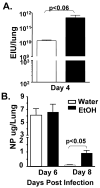
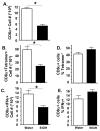

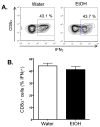
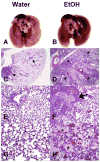
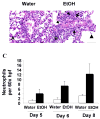
Comment in
-
Comment on "Chronic alcohol consumption increases the severity of murine influenza virus infections".J Immunol. 2008 Nov 1;181(9):5813; author reply 5813-4. doi: 10.4049/jimmunol.181.9.5813. J Immunol. 2008. PMID: 18941167 No abstract available.
References
-
- Jennings LC, Anderson TP, Beynon KA, Chua A, Laing RT, Werno AM, Young SA, Chambers ST, Murdoch DR. Incidence and Characteristics of Viral Community-Acquired Pneumonia in Adults. Thorax. 2008;63:42–48. - PubMed
-
- Angeles Marcos M, Camps M, Pumarola T, Antonio Martinez J, Martinez E, Mensa J, Garcia E, Penarroja G, Dambrava P, Casas I, Jimenez de Anta MT, Torres A. The role of viruses in the aetiology of community-acquired pneumonia in adults. Antivir Ther. 2006;11:351–359. - PubMed
-
- Fauci AS. Race against time. Nature. 2005;435:423–424. - PubMed
-
- Horimoto T, Kawaoka Y. Influenza: lessons from past pandemics, warnings from current incidents. Nat Rev Microbiol. 2005;3:591–600. - PubMed
-
- LaForce FM, Nichol KL, Cox NJ. Influenza: virology, epidemiology, disease, and prevention. Am J Prev Med. 1994;10 Suppl:31–44. - PubMed
Publication types
MeSH terms
Substances
Grants and funding
LinkOut - more resources
Full Text Sources
Medical
Research Materials

